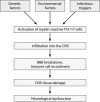The emerging role of p38 mitogen-activated protein kinase in multiple sclerosis and its models
- PMID: 23897428
- PMCID: PMC3811866
- DOI: 10.1128/MCB.00688-13
The emerging role of p38 mitogen-activated protein kinase in multiple sclerosis and its models
Abstract
Multiple sclerosis (MS), the most common disabling neurologic disease of young adults, is considered a classical T cell-mediated disease and is characterized by demyelination, axonal damage, and progressive neurological dysfunction. The currently available disease-modifying therapies are limited in their efficacy, and improved understanding of new pathways contributing to disease pathogenesis could reveal additional novel therapeutic targets. The p38 mitogen-activated protein kinase (MAPK) signaling pathway is known to be triggered by stress stimuli and to contribute to inflammatory responses. Importantly, a number of recent studies have identified this signaling pathway as a central player in MS and its principal animal model, experimental allergic encephalomyelitis. Here, we review the evidence from mouse and human studies supporting the role of p38 MAPK in regulating key immunopathogenic mechanisms underlying autoimmune inflammatory disease of the central nervous system and the potential of targeting this pathway as a disease-modifying therapy in MS.
Figures



Similar articles
-
Sex-specific control of central nervous system autoimmunity by p38 mitogen-activated protein kinase signaling in myeloid cells.Ann Neurol. 2014 Jan;75(1):50-66. doi: 10.1002/ana.24020. Ann Neurol. 2014. PMID: 24027119 Free PMC article.
-
ICAM-1-induced expression of proinflammatory cytokines in astrocytes: involvement of extracellular signal-regulated kinase and p38 mitogen-activated protein kinase pathways.J Immunol. 2000 Oct 15;165(8):4658-66. doi: 10.4049/jimmunol.165.8.4658. J Immunol. 2000. PMID: 11035109
-
p38MAPK/SGK1 signaling regulates macrophage polarization in experimental autoimmune encephalomyelitis.Aging (Albany NY). 2019 Feb 4;11(3):898-907. doi: 10.18632/aging.101786. Aging (Albany NY). 2019. PMID: 30716717 Free PMC article.
-
The role of glycogen synthase kinase 3 beta in multiple sclerosis.Biomed Pharmacother. 2020 Dec;132:110874. doi: 10.1016/j.biopha.2020.110874. Epub 2020 Oct 18. Biomed Pharmacother. 2020. PMID: 33080467 Review.
-
Role of Mast Cells in the Pathogenesis of Multiple Sclerosis and Experimental Autoimmune Encephalomyelitis.Clin Rev Allergy Immunol. 2017 Jun;52(3):436-445. doi: 10.1007/s12016-016-8595-y. Clin Rev Allergy Immunol. 2017. PMID: 28025778 Review.
Cited by
-
Multiple Sclerosis: Roles of miRNA, lcnRNA, and circRNA and Their Implications in Cellular Pathways.Int J Mol Sci. 2024 Feb 13;25(4):2255. doi: 10.3390/ijms25042255. Int J Mol Sci. 2024. PMID: 38396932 Free PMC article. Review.
-
FAK contributes to proteinuria in hypercholesterolaemic rats and modulates podocyte F-actin re-organization via activating p38 in response to ox-LDL.J Cell Mol Med. 2017 Mar;21(3):552-567. doi: 10.1111/jcmm.13001. Epub 2016 Oct 5. J Cell Mol Med. 2017. PMID: 27704688 Free PMC article.
-
Genetic Deletion of LRP5 and LRP6 in Macrophages Exacerbates Colitis-Associated Systemic Inflammation and Kidney Injury in Response to Intestinal Commensal Microbiota.J Immunol. 2022 Jul 15;209(2):368-378. doi: 10.4049/jimmunol.2101172. Epub 2022 Jun 27. J Immunol. 2022. PMID: 35760519 Free PMC article.
-
Sulforaphane-Enriched Broccoli Sprouts Pretreated by Pulsed Electric Fields Reduces Neuroinflammation and Ameliorates Scopolamine-Induced Amnesia in Mouse Brain through Its Antioxidant Ability via Nrf2-HO-1 Activation.Oxid Med Cell Longev. 2019 Mar 27;2019:3549274. doi: 10.1155/2019/3549274. eCollection 2019. Oxid Med Cell Longev. 2019. PMID: 31049133 Free PMC article.
-
The sex-specific role of p38 MAP kinase in CNS autoimmunity is regulated by estrogen receptor alpha.J Neuroimmunol. 2020 Mar 4;342:577209. doi: 10.1016/j.jneuroim.2020.577209. Online ahead of print. J Neuroimmunol. 2020. PMID: 32200131 Free PMC article.
References
-
- Ebers GC. 2008. Environmental factors and multiple sclerosis. Lancet Neurol. 7:268–277 - PubMed
-
- Frohman EM, Racke MK, Raine CS. 2006. Multiple sclerosis—the plaque and its pathogenesis. N. Engl. J. Med. 354:942–955 - PubMed
-
- Greenstein JI. 2007. Current concepts of the cellular and molecular pathophysiology of multiple sclerosis. Dev. Neurobiol. 67:1248–1265 - PubMed
-
- Stromnes IM, Goverman JM. 2006. Active induction of experimental allergic encephalomyelitis. Nat. Protoc. 1:1810–1819 - PubMed
-
- Steinman L, Zamvil SS. 2006. How to successfully apply animal studies in experimental allergic encephalomyelitis to research on multiple sclerosis. Ann. Neurol. 60:12–21 - PubMed
Publication types
MeSH terms
Substances
Grants and funding
LinkOut - more resources
Full Text Sources
Other Literature Sources
Medical
